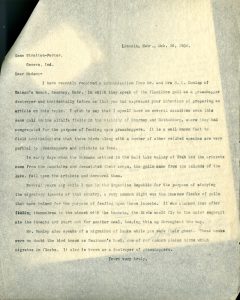Great Nebraska
Naturalists and ScientistsNOU, Lawrence Bruner, Letter, 1906, Mar. 26
 Lincoln, Nebr., Mch. 26, 1906.
Lincoln, Nebr., Mch. 26, 1906.
Gene Stratton-Porter Geneva, Ind.
Dear Madam:- I have recently received a communication from Mr. and Mrs. N. C. Dunlap of Watson’s Ranch, Kearney, Nebr. in which they speak of the Flanklins gull as a grasshopper destroyer and incidentally inform me that you had expressed your intention of preparing an article on this topic. I wish to say that I myself have on several occasions seen this same gull in the alfalfa fields in the vicinity of Kearney and Gothenburg, where they had congregated for the purpose of feeding upon grasshoppers. It is a well known fact to field ornithologists that these birds along with a number of other related species are very partial to grasshoppers and crickets as food. In early days when the Mormans settled in the Salt Lake valley of Utah and the crickets came from the mountains and devastated their crops, the gulls came from the islands of the lake, fell upon the crickets and devoured them. Several years ago while I was in the Argentine Republic for the purpose of studying the migratory locusts of that country, a very common sight was the imense flocks of gulls that came inland for the purpose of feeding upon these insects. It was claimed that after feeding themselves to the utmost with the insects, the birds would fly to the water regurgitate the insects and start out for another meal, keeping this up throughout the day. Mr. Dunlap also speaks of a migration of hawks while you were their guest. These hawks were no doubt the bird known as Swainson’s hawk, one of our common plains birds which migrate in flocks. It also is known as a destroyer of grasshoppers. Yours very truly,